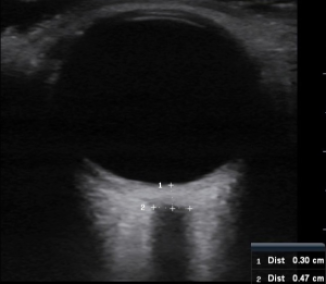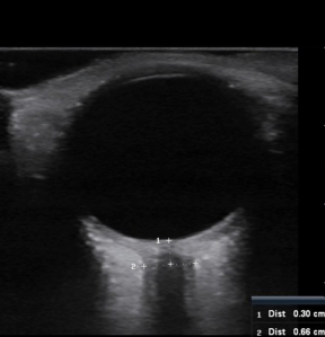Hey sono enthusiasts! Exciting news! SonoMojo was recently featured on Critical Care Practioner Podcast! “Episode 37: How to Make Ultrasound Easier” features myself and the SonoMojo site in an episode discussing how to make learning ultrasound easier through #FOAMed resources and strategies for learning ultrasound. I’m so thrilled about the whole experience and getting to work with fellow FOAMer Jonathan Downham. Jonathan is a class act and he’s put together a great episode! Be sure to check it out!
Life in the eFAST Lane: Sonography for Trauma (Part 2)

Figure 1 – An eFAST Rockstar in Action
How to Do I Perform an eFAST? (Continued from Part 1)
Pelvis
Probe position
- Probe marker towards patient’s head (longitudinal view) or towards patient’s right (transverse view).
- Place the probe just above the pubic symphysis and look for the bladder in men and both the bladder and uterus in women.
- If it’s not awkward, it’s not right and you’re not low enough.
- Once you’ve completed the longitudinal view, turn your probe 90° for the transverse view. Both views should be evaluated to avoid false positives.
Continue reading Life in the eFAST Lane: Sonography for Trauma (Part 2)
Life in the eFAST Lane: Sonography for Trauma (Part 1)
This is the first of a three part series reviewing the eFAST scan in detail. The goal of this series is to aid new ultrasound users to perform their first eFAST scan correctly and improve existing sonographer’s understanding of the eFAST.
The Case
There are just too many eFAST cases to choose from. Which one to tell you…? Should I talk about my first eFAST patient, the supposed-to-be-simple-but-really-wasn’t, coumadin guy who laid out his motorcycle? What about the lady from the rollover down a twenty foot embankment? Or the teenager from a horseback riding accident? Should I tell you about the night I hung out in resuscitation and did an eFAST on every patient that came through? A December night in medical school I like to think of as Ultrasound Christmas. A night when a trauma alert rolled in and before I knew what was happening, the resident put the ultrasound probe in my hand and said “Go for it!” Needless to say it was AWESOME! Like do-a-secret-happy-dance-in-the-hallway-afterwards kind of awesome. I definitely loved my ultrasound elective, especially once I became competent at eFASTs. So what’s an eFAST you ask? It’s simple really. It’s a systematic ultrasound scan to check for pneumothorax and free fluid (usually blood) in the abdomen and chest. It’s quick, easy, and incredibly useful. You don’t have to be a genius for this stuff. My first year med students can do this and so can you! If you’re going to spend time in the Emergency Department or with critically ill patients, you should learn the eFAST. End of story. So now that you’re convinced… just how do you do an eFAST?
What’s eFAST All About?
The eFAST is a fast (pun intended) and easy way to check for blood in the chest and abdomen. Continue reading Life in the eFAST Lane: Sonography for Trauma (Part 1)
New SonoMojo Resource: DVT Ultrasound Cheat Sheet
A new SonoMojo Ultrasound Cheat Sheet is here! The DVT cheat sheet is a brief review of DVT bedside ultrasound. You can use it for a quick review of the essentials before performing a scan or an overview of the key points before diving into learning DVT ultrasound.
In case you don’t know what an Ultrasound Cheat Sheet is…. they’re all the basic info you need to review before performing (or teaching) a specific ultrasound scan. They are 1-2 pages long and consist of an brief check list of information on the application, image acquisition, and interpretation of a scan.
So be sure check out the newest installment of Ultrasound Cheat Sheets, DVT ultrasound, on the Ultrasound Cheat Sheets page!
New SonoMojo Resource: eFAST Ultrasound Cheat Sheet
There’s a new SonoMojo Ultrasound Cheat Sheet! The eFAST Ultrasound Cheat Sheet is here! In case you don’t know what an ultrasound cheat sheet is…
Ultrasound cheat sheets are all the basic info you need to review before performing (or teaching) a specific ultrasound scan. They are 1-2 pages long and consisting of an brief check list of information on the application, image acquisition, and interpretation of a scan.
Be sure to check out the latest ultrasound cheat sheet, the eFAST, on the Ultrasound Cheat Sheets page!
Keeping an Eye on Intracranial Pressure: Detecting Elevated ICP Using Ocular Ultrasound
The Case
Generally, I like to write about positive ultrasound cases. This is not one of those cases. But out of this sad case there was much learning to be had for this med student. At the time of the case, I was on an emergency ultrasound elective. And I couldn’t have be happier! I was learning all sorts of awesome and useful skills. Another perk of being on ultrasound duty was that I got to tag along on all the ultrasound cases I can get my hands on, including the traumas (a big perk in my book). As soon as I heard a trauma called in, I gowned up, gloved up, goggled up, and masked up. I observed the FAST exam (Focused Abdominal Scan for Trauma) and helped however I was instructed. Mostly squeezing IV bags or fetching things, but I was in there; I had a job; and I was learning ultrasound awesomeness. Life was good…. like really, really good. Until it wasn’t. Enter a teenager in an ATV accident. One paramedic cranks out compressions, while the other relays patient information. Car versus ATV. Trouble intubating. And he’s asystolic. Huge bummer. This is not going to be fun and someone somewhere is going to be very sad tonight. Everyone is hustling. I stand at the foot of the bed squeezing fluids into the kid while lines are placed, drugs are pushed, and they figure out what’s wrong. I watch the FAST exam. Looks negative to me, so no visible blood in the pelvis, abdomen, or around the heart. Unfortunately the ultrasound’s heart view also shows no heart movement. There is no electrical activity on the ECG. He’s been down for a long time. Time of death is called. Everyone puts down what they were doing and steps away. I feel heavy. After the room has cleared, the ultrasound attending pulls the ultrasound up to the bedside. There is a valuable teaching opportunity here. He does another FAST exam, explaining it as he goes. Still no free fluid in the pelvis, abdomen, or pericardium. He puts the probe on his chest. No signs of pneumo or hemothorax. This is weird; an ATV versus car with no major bleeding from the neck down. I’m supposed to be learning what an ultrasound exam looks like on a trauma patient, but so far it all looks pretty normal. That’s odd… so what killed this kid? The ultrasound attending agrees it’s unusual and wants to check one more thing. Here’s where things get interesting. The only visible trauma is from the neck up; some bleeding from the ears, eyes, and an open scalp lac. With no helmet that really isn’t a surprise. What is a surprise is the ultrasound attending putting the ultrasound probe on his eye. What are we suppose to tell from this..? Intracranial pressure. Mind blow. Now I’m pretty sure the ultrasound attending is a wizard. On the screen, we see a normal globe with a huge optic nerve and sheath exiting. Before he even measures it, he can tell it’s too big. He measures it and confirms ICP is elevated. So how’d he do this?
Measuring Intracranial Pressure Using Ocular Ultrasound
In a Nutshell
- If you suspect elevated intracranial pressure (ICP), ocular ultrasound is a fast and easy method to detect it.
- You can measure the optic nerve sheath diameter (ONSD) using ultrasound.ONSD > 5 mm may indicate an ICP > 20 mmHg, especially in symptomatic patients.
- Not everyone with ONSD > 5 mm has elevated ICP.
- ONSD > 5.7 mm indicates an ICP > 20 mmHg.
- All patients with ONSD > 5.7 mm have elevated ICP.


Call for Ultrasound Interest Groups!
Calling all med students (and their awesome ultrasound faculty mentors)! Are you interested in bedside ultrasound? Do you wish you could have more ultrasound education? Do you want to make a difference and bring ultrasound education to your medical school? Do you wish you could do something to influence ultrasound curriculum integration? If you answered yes to any of these question, you’re a perfect candidate to start your own Ultrasound Interest Group (USIG)!
Seriously, you can use a USIG to accomplish all kinds of awesome things at your medical school, like organizing regular ultrasound education, introducing other medical students to bedside ultrasound, creating an ultrasound community among students and faculty, and using USIG generated student interest in ultrasound to promote ultrasound curriculum integration. It’s not hard and other students, just like you, have founded and run their own USIGs! To make it even easier SonoMojo has put together a USIG Toolbox with all the info you need to start and run your own USIG. It’s got a ton of useful resources, so check it out!
If you’re interested in starting a USIG at your school, please contact us (sonomojoUS@gmail.com). We’re here to help and we’ll get you connected with other students who’ve started their own USIG too! Happy ultrasounding everyone!
Learning Ultrasound in Ultrasound Naive Learning Environments
Are you a medical student or physician trying to incorporate ultrasound in your clinical education? Is your clinical environment not so ultrasound friendly? SonoMojo’s got you covered. Check out our Vimeo post on “Learning Ultrasound in Ultrasound Naïve Environments“. It covers strategies for introducing ultrasound to the conversation, positively influencing patient care & hospital ultrasound culture, and creating your own ultrasound education in the absence of a formal ultrasound curriculum. Enjoy the post and happy ultrasounding!
Learning Ultrasound in Ultrasound Naive Learning Environments from SonoMojo on Vimeo.
Welcome to SonoMojo!
SonoMojo is a guide to ultrasound education. It’s a place for the new-to-ultrasound to get started in bedside ultrasound education and for the ultrasound-pro to discover new ultrasound resources. We’ve collected the best of FOAMed ultrasound education in one place. We’ve also added a few of our own SonoMojo ultrasound resources to help you on your path to become an ultrasound master.
Be sure to check out these SonoMojo features:
- Comprehensive Ultrasound Curriculum– our online FOAM-based ultrasound curriculum HERE
- Orientation to Ultrasound Education Resources– an orientation to the best ultrasound education resources for getting started in bedside ultrasound HERE
- Guide to Advancing Your Skills– a collection of suggested ultrasound education resources that will take your ultrasound skills to the next level once you’ve got the basics down HERE
- Ultrasound Interest Group Toolbox– a how-to guide for creating medical student ultrasound education using an Ultrasound Interest Group HERE
Please enjoy the site! Happy ultrasounding!